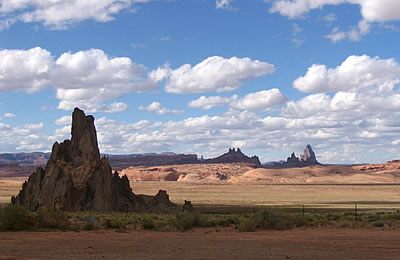| |
Canyons of the Heart
Part 1: Climbing with the ghosts of the ancients
In the USA, we all are immigrants, all travelers from another land. But in
the American Southwest, the past remains to remind us that we are the recent arrivals,
that Native Americans arrived here long ago and adapted to living here. In
some places the Native Americans consciously protected their culture from the
influence of the new immigrants from Europe. One such place is Acoma Pueblo, which
is a village located atop a flat-topped tower of stone called a mesa. The word
pueblo comes from the Pueblo Indians, Native American peoples, including the Hopi,
Zuñi, and Taos, descendants of the cliff-dwelling Anasazi peoples. These
people developed unique village communities to which they lent their name: pueblo.
Typically those villages consist of flat-roofed adobe, a sun-dried brick of clay
and straw or stone apartment dwellings in groups sometimes several stories high.
Such as those at Acoma Pueblo. Acoma
Pueblo has been continuously inhabited by Pueblo Indians since ancient times.
On top of the mesa, the adobe apartments stand today as they have for centuries.
A more recent addition is a church, now hundreds of years old, but without a resident
priest. There is a priest who visits by invitation. After years of struggle with
the Church, the people finally accepted the Catholic faith, but never gave up
their own beliefs. To protect their culture, they limit the visits of outsiders.
Their church on top of the mesa incorporates their own spiritual symbols. Outside
its doors is a cemetery 40 feet deep with layers of ancestors 'replanted', as
the Acoma say, in earth hauled up from below on the backs of Acoma women, basketful
by basketful. The mesa upon which
the village stands has sheer rock cliffs. Standing on the edge with the wind and
sun equally strong on your face, you look across the flat landscape to where other
mesas rise in the distance. There is safety here, in being able to see the approach
of enemies, and having a position atop the stone tower, making it difficult to
attack and easy to defend. But it is a difficult place, too, exposed to the elements
and requiring a lot of effort to supply. There is a way up and down, and we climbed
down it, down the stone steps with handholds carved into the rock walls, carved
so long ago and used by generations of this tribe. Climbing with the ghosts of
the ancients, on the stones rounded from their footsteps, down to the semi-arid
grassland below, punctuated with cottonwood trees dressed in golden foliage aglow
in the afternoon sun. Down to a road with the occasional adobe house, like the
ones on the mesa. Rising from this floor were other amazing rock formations. Smaller,
fractured towers of stone, smoothed and rounded by the wind.
Part
2: An infinite variety of forever vistas
this
travelogue is part of the subside travelzine
about
bookshelf links contact
submit
..
| |
